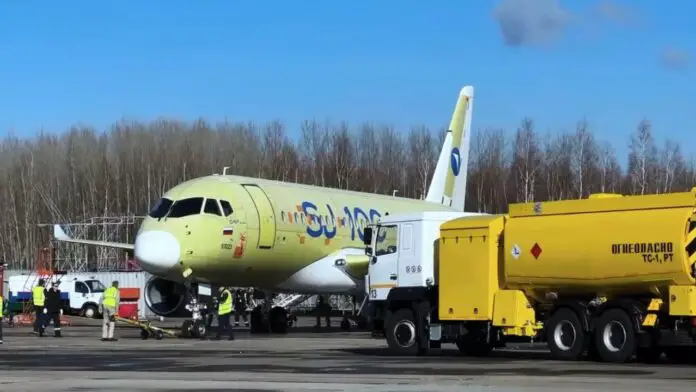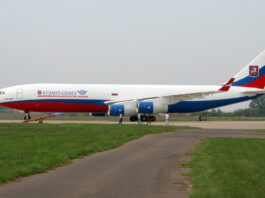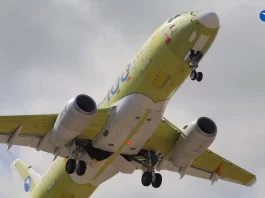The first Superjet 100 (SJ-100) to be powered by domestically produced PD-8 engines is a significant milestone in Russia’s pursuit of aviation self-sufficiency, particularly in light of the disruption of access to foreign aircraft components by Western sanctions. The SJ-100 equipped with PD-8 engines, made its inaugural flight in March 2025 at Komsomolsk-on-Amur. The flight lasted approximately 40 minutes. The aircraft achieved an altitude of up to 3,000 meters and a speed of 500 km/h during this flight.
The aircraft was subjected to new operational limits for the PD-8 engines during the next test flight, achieving a maximum angle of attack of 25 degrees and a minimum speed of 183.348 km/h (99 knots). This was a substantial improvement over the PD-8 engine’s performance in previous tests performed on an Il-76 flying laboratory, which took place at minimum speeds of 227.8 km/h (150 knots) and angles of attack up to 16 degrees. These evaluations are essential for the assessment of the engine’s performance in difficult flight conditions and for the advancement of the aircraft’s warning and protection systems, which are intended to prevent the aircraft from exceeding critical angles of attack.
The real-world implications of these test results for the PD-8 engines are multifaceted, affecting industrial development, aircraft performance, and aviation safety. The tests demonstrate a significant advance over previous benchmarks (16 degrees and 227.8 km/h) by propelling the engine to a minimum speed of 183 km/h (99 knots) and a 25-degree angle of attack. Due to this expanded flight envelope, the engine is capable of operating consistently in more severe conditions, including emergency maneuvers, turbulent weather, or precipitous takeoffs. This results in improved safety for commercial aircraft such as the Sukhoi Superjet 100, as it minimizes the likelihood of engine flameouts or stalls in critical low-speed situations.
The engine’s durability and design substantiation are additional critical components. The PD-8’s capacity to operate at greater angles of attack serves as confirmation of its combustion efficiency and aerodynamic stability, thereby resolving previous apprehensions regarding Russian-manufactured jet engines. These experiments also facilitate the advancement of sophisticated flight control and warning systems, which aid in preventing pilots from exceeding hazardous flight parameters. Engineers can enhance automated protections that reduce human error, a critical factor in preventing loss-of-control accidents—one of the most common causes of aviation fatalities—by incorporating data from these trials.
The successful testing of the PD-8 is a significant milestone for Russia’s aerospace industry from both an economic and strategic standpoint. It is especially crucial in light of the ongoing trade restrictions and sanctions, as it decreases dependence on foreign engine suppliers. The PD-8, a high-performance engine that is domestically produced, enhances the competitiveness of Russian aircraft, including the SSJ100. This advancement is consistent with the overall goals of technological self-sufficiency and has the potential to generate export opportunities in markets that are in search of alternatives to Western-made aircraft.
In the final analysis, these assessments are not solely concerned with technical milestones; they also have tangible consequences for airlines, passengers, and pilots. In challenging environments such as high-altitude airports or limited runways, the aircraft enhances its versatility by being able to operate safely at lower speeds and steeper angles. The PD-8’s demonstrated success in extreme conditions will be a critical factor in the restoration of confidence in Russian aviation and the expansion of its global presence as it approaches certification.
The PD-8 engine is a turbofan that was domestically conceived and developed by the United Engine Corporation (UEC), which is a subsidiary of Rostec. It is designed to replace the SaM146 engine, which was significantly reliant on Western technology. The PD-8 employs Russian-made control systems, gasoline units, and other critical components and incorporates design features and technological lessons from the larger PD-14 engine. Robust safety and reliability have been demonstrated across all tested modes, as evidenced by the engine’s extensive ground and flight testing, which includes assessments of high-temperature endurance and fire resistance.
The supply chain and maintenance requirements of the two engines are among the most critical distinctions. The SaM146 was susceptible to geopolitical disruptions due to its substantial dependence on French components and technical support. Many SSJ100s were grounded as a result of a paucity of spare parts and maintenance capabilities following the imposition of Western sanctions in 2022. The PD-8, which is entirely manufactured in Russia, eliminates this dependence, thereby guaranteeing that operators can maintain their fleets without the need for foreign assistance. This change is essential for the SSJ100 program’s long-term sustainability and is consistent with Russia’s overarching aim of attaining self-sufficiency in aerospace technology.
In the future, the PD-8 will be a component of a broader family of Russian engines, which includes the PD-14, which is used in the MC-21 airliner. This commonality provides the opportunity for future enhancements, including hybrid-electric adaptations and sophisticated digital control systems. In contrast, the SaM146 lacked a clear upgrade path, notably following the dissolution of the Franco-Russian partnership. Although the PD-8 requires further validation in commercial service, its superior performance metrics and domestic production render it a critical element in Russia’s endeavors to revitalize its civil aviation industry and decrease its dependence on foreign technology.
Official Website of Youtube Channel – Altitude Addicts




